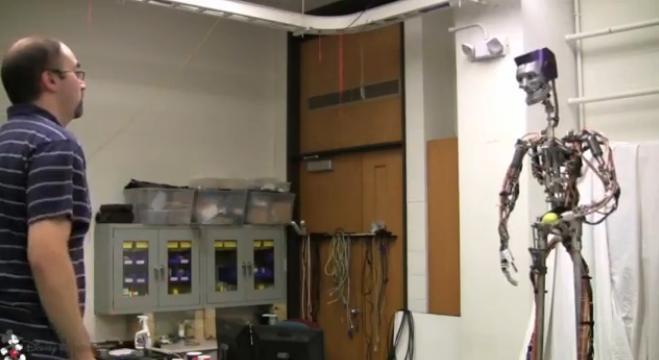Every Friday, Future Tense rounds up the best robot videos of the week. Seen a great robot video? Tweet it to @FutureTenseNow, or email us.
This week, robots get classical, cruise around under the sea, and get just plain gross.
The Juggling Bot
It didn’t take Disney long to begin exploiting two of science fiction’s most iconic robots, but whatever bad blood they created with Star Wars fans might be redeemed with the company’s newest (real-life) humanoid. Disney Research in Pittsburgh built this robot to use in theme parks, where animatronic characters abound but can’t interact with guests. The robot was built to play catch with people—a task researchers chose because it allows interaction without potentially dangerous physical contact. A camera system tracks balls in the air, and a hand mechanism catches and returns the balls with natural, humanlike motions. The camera system can also track people’s faces, allowing the robot to turn and look at people as they move. Best of all, the robot will hang its head in shame when it drops a ball. For now these bots are just dreams in Tomorrowland, but some day in the future we might all play catch with Abe Lincoln in Anaheim.
Via Smithsonian.
The Beethoven Bots
Beethoven said music is the mediator between the spiritual and sensual life. If that’s true, here’s the mechanical equivalent of demigods, or something. Designed at the Georgia Institute of Technology, these little rolling pods, called Khepera bots, dance around a virtual keyboard, communicating with one another to pump out a very slow version of Beethoven’s own “Für Elise.” This is more than a musical performance, though—what’s really on display is an algorithm for a group of robots to follow a hierarchy of leadership to complete a task. The top-dog robot communicates tasks to its direct followers, and those middle managers parse the information and send it to their followers, ensuring each robot can move most efficiently to where it is needed. In this case, “Für Elise” is the product of the so-called group-based leader-follower control system, and is a demonstration of how complex swarms of drones could govern themselves when told to complete a task.
Via Gadget Lab.
The Sea Turtle Bot
Robots rarely look as peaceful and true to form as Naro-Tartaruga, a robotic sea turtle from ETH Zurich. While many designs for underwater robots draw inspiration from fish or jellyfish, researchers looked to turtles for this machine because of their capacity to carry a large payload. The broad, flat body can store components inside or carry items on top, and its sleek design gives it a top speed of more than 4 mph. Unlike other animatronic robots, this one moves so naturally, you might mistake for a real turtle from a distance. And if it can actually shuttle a human around, as suggested at the end of the video, this could be the best new beach tourist activity since the Snuba. Anyone wanna go snurtling?
Via IEEE Spectrum.
The Freewheeling Bot
Why keep a robot in a cage? In this case, to let it roam free. Researchers at the Illinois Institute of Technology built the HyTAQ robot by surrounding a quadrotor with a cylindrical polycarbonate and carbon fiber frame. The frame functions as a wheel, and doesn’t stifle the lift from the rotors, so the bot can roll around the ground on a variety of surfaces and seamlessly fly into the air whenever it needs. Rolling around takes up much less energy than flying, extending the quadrotor’s battery life significantly—up to six times longer, according to the team’s website.
Via Discovery News.
The Bovine Bot
A team from the Sustainable Agriculture Flagship in Australia has designed small, winged devices to study the ever-growing problem of greenhouse gas emissions. They won’t be flying in the upper atmosphere, though. No, they’ll be using those wings to keep themselves in the digestive tracts of cows for weeks, monitoring the methane gases released from bovine burps and farts. Essentially, the devices will be looking to see what gives cows gas and how changes to a cow’s diet could minimize its Earth-warming flatulence. They’ll collect data and transmit it wirelessly, so different foods can be tested in real time. There’s no video of this one, and that’s a good thing.
